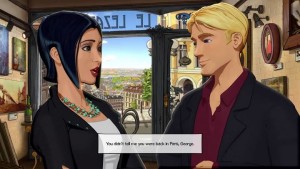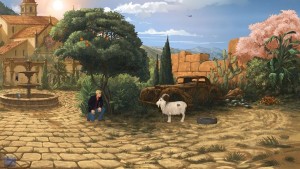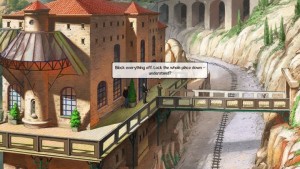Broken Sword 5: The Serpent’s Curse is a point and click adventure game available for download from the PlayStation Store for the PS Vita and is now making its debut on the PS4 and for the first time from retail stores. The legacy of the Broken Sword saga is unquestionable and has been since its inception on the original PlayStation in 1996.
Broken Sword: The Shadow of the Templars introduced players to a new era of the point and click adventure on games consoles featuring the central character of the series George Stobbart’s investigations into all manner of criminal behaviour, which is offset by his own trademark humour and sarcasm. The Broken Sword series has spawned five games and remakes of the first initial first two with each being a commercial and critical success. The series has won a number of awards and many nominations from Broken Sword: The Shadow of the Templars winning best adventure from Generation 4 and best quest from Quest magazine in 1997 to Broken Sword: The Sleeping Dragon winning the best adventure game of 2003 from Just Adventure and earning nominations in best design, best P.C. game and best adventure game from the British Academy Video Games Awards in 2003 as well as a nomination for excellence in writing from the Game Developers Choice Awards in 2004, alongside many other well deserved awards and award nominations that have only further cemented Broken Sword’s legacy in the point and click adventure genre.
The story starts in a Catalan village as it is stormed by Spanish fascists as they are in search of a particular painting in the year 1937. Fast forward to present day Paris and a robbery and murder is committed to steal the very same painting that a priest claims to have evil powers from a curse that was forged by the devil himself. George Stobbart and Nico Collard must investigate the murder and robbery until they get to the bottom of who stole the painting and committed the murder, alongside attempting to find if the painting really is cursed with an evil presence.
The dialogue provides a lot of humour particularly from the lead character George Stobbart, in a story and dialogue written by the creator, writer and director of the Broken Sword series Charles Cecil. There is a scene early on in the game in which an art critic the player needs to speak to has fainted; after being sprayed with some overpowering cologne towards his face to wake him up he asks George, “What was that? It smells like…like the Seventies”. There are humorous and sarcastic comments throughout the dialogue that will always give you a laugh, which is a really positive design choice as a script that can put a smile on the face is always a script well written.
The character design is pretty good as they all have their own unique looks, styles, mannerisms and voices that clearly differentiate one character from another. George Stobbart is an excellent lead character with his humour and sarcasm and Nico Collard is just as good as a helpful investigative journalist with her charm and intelligence, alongside an entire supporting cast of brilliant characters that each standout from one another, regardless of if they are the good or bad guys.
The environment design is just as good as the character design as they merge together to create many amazing scenes played out across some equally as extravagant locations, such as modern day Paris with many great background details allowing the surroundings to feel as would be expected in the real world.
The puzzles are usually all connected in some way which is a positive design choice as it means that an entire set of puzzles are relevant to each other and important to making progression through the story which makes them feel much more rewarding after being solved and provides more of a purpose to the puzzles, rather than just being a single randomly placed standalone puzzle.
A great example of this is from early on in the game in which the player has to blackmail a code to a safe out an art critic by proving that he was lying about his whereabouts, while having Nico distract the investigator who had just entered as the safe is being attempted to open. However, Nico cannot enter the art gallery as the investigator’s guard has been instructed to not allow anyone in; when the player has figured out a rather amusing way past the guard, players will find that the investigator is only interested in blood related evidence which is deliberately falsified using tomato sauce from the underside of a pizza box that was conveniently dropped on the floor by George earlier on, although the tomato sauce does have a piece of chewing gum stuck in the centre of it that has to be removed with Nico’s press card. The tomato sauce having been made to look exactly like a blood splatter on the floor is just what is required for the investigator to be distracted to buy George enough time to sneak into the safe and find multiple threads of evidence that provides the leads to guide him in the appropriate direction for his investigation.The inventory allows items to be collected that are important to the investigation and use them to progress in the appropriate direction. Items can be assessed or used to interact with the surrounding environments or perhaps even used to gain leverage over another character that otherwise refuses to co-operate in aiding the investigation by effectively blackmailing that character with evidence that could incriminate him or her as a suspect.
An all-new feature to the PS4 release is the character gallery which includes the name, a detailed biography and a picture of the character with a total of 33 characters which are unlocked as the player progresses through the story, although it is an excellent feature it would have been even better if instead of a still picture; there would have been a fully 3D character model with a camera which could rotate around and zoom in or out, alongside some of each character’s most humorous dialogue. An exclusive feature to the retail release is a printed comic book which acts as a lead into the story found within the game by providing some back-story in the form of a prelude which is an excellent design choice and great for Broken Sword and comic book fans alike.
The controls are well mapped having translated appropriately from the Vita to the DualShock 4 controller with the control scheme consisting of pressing triangle to produce the contents of the inventory, pressing square to examine an inventory item, a character or part of the surrounding environment, pressing X to start or continue a conversation with a nearby character, select an item, use an item or walk, pressing O to cancel the selection or usage of an item, changing the direction of the left analogue stick to move the cursor, changing the direction of the right analogue stick to pan the camera to the left or right, pressing left, right, up or down on the d-pad or alternatively changing the direction of the left analogue stick to navigate through the inventory items, pressing the share button takes players to the share feature menu and pressing the options button to display the pause menu including immediate access to the main menu, hints, character gallery and saving.
The Vita’s touch screen controls have mostly been mapped to the touch pad of the DualShock 4 controller such as swiping across the touch pad to move the cursor or navigate through inventory items and tapping the touch pad to start or continue a conversation with a nearby character, select, use or examine an item or walk. The DualShock 4 controller only vibrates when the left analogue stick has moved the cursor over an object, although rather strangely it will not vibrate when the touch pad moves the cursor over an object, while there is no light bar implementation which could have produced a separate colour for George and Nico when controlling either character or unique colours for individual inventory items.
Graphically, the PS4 version outputs at 1080p with more animations which naturally improves the look of the game in comparison to previous releases, while retaining a stylised cel-shaded visual approach. The characters, surrounding environments and objects are all very bright and colourful with plenty of detail that collectively works extremely well and makes the world come alive right before the player’s very eyes which is further complemented by excellent animations for all of the characters.
The presentation of the game is solid with a great user interface across various menus such as the main, character gallery, options and various gameplay menus with support for navigation via the left analogue stick, directional pad, face buttons and touch pad, although there is no support for navigation via the right analogue stick. The background of the main menu screen consists of a piece of architecture that most probably ties in with the painting that is at the heart of the storyline.
The audio consists of voice-overs, sound effects and music which really add layers to the charm and humour of the game with the voice-overs being the standout area of audio with each character having a personality via exceptional performances from their respective voice-over artists.
There is some returning voice-over talent from previous Broken Sword games and some new voice-over talent that form a very experienced cast with Rolf Saxon returning as lead voice-over artist for Broken Sword’s series protagonist George Stobbart who has voiced George Stobbart in every Broken Sword game since the original in 1996 with plenty of experience in film and television productions such as Saving Private Ryan as Lieutenant Briggs, Entrapment as a director and the U.S. president in two episodes of the British comedy television series Little Britain.
Emma Tate who voices Nico Collard, Maria de Santos, a young Tiago Marques and Sofia has a massive amount of experience in voice-overs having voiced characters in television series including Captain Scarlet, The Jungle Book and Angelina Ballerina alongside roles in videogames such as Telltale’s Wallace and Gromit episodic games, Rogue Trooper, Shinobido, Dragon Age II, Dragon Age: Inquisition, LEGO: The Hobbit and Bloodborne. Nicholas Boulton voices Richard Langham having voiced characters in Killzone 3, The Witcher 2, Mass Effect 3 and Final Fantasy XIV: Heavensward. Toby Longworth voices Marques having voiced Senator Lott Dodd and Gragra in Star Wars: Episode I – The Phantom Menace as well as videogames such as Tropico 5, Sacred 3 and Risen 3: Titan Lords. Terry Wilton voices Father Simeone and Vlad having previously narrated the Trine games as well as others forming an incredibly talented cast.
The sound effects breathe some life into the world such as characters walking, interacting with objects and birds chirping, while the music is an appropriate classical soundtrack. The DualShock 4 speaker implementation produces a clicking sound effect when a character, item or conversation has been selected, while an additional sound effect is produced when an item is added to the inventory or a character is unlocked for the character gallery, alongside the voice of the character George is talking to during phone conversations.
The trophy list includes 34 trophies with 23 bronze, 4 silver, 6 gold and 1 platinum trophy. The trophy list is essentially easy as all but 7 of the trophies are story related, therefore 27 trophies will be earned naturally as progression is made through the story with the only difficulty coming from the 7 missable trophies that are relatively easy if the player knows what to do and when to do it. The story related trophies includes the Order of the Goat gold trophy for outwitting the irritated goat, while there are 7 missable trophies including the Notorious P.U.G gold trophy for finding all of the hidden pugs in the neighbour’s apartment, the Joey silver trophy for finding all of the hidden Joeys, the Hidden Goat silver trophy for finding the hidden goat and the Local Call gold trophy for chilling out to Radio Yorkshire. It is estimated that depending upon skill and a good trophy guide to provide some helpful tips to find the hidden objects for the 7 missable trophies that it would take anywhere from 15 to 20 hours to platinum the trophy list.
There are no difficulty levels, but there are plenty of puzzles to solve, resulting in the difficulty level being the equivalent to how hard the player may find the puzzles to overcome. There will be a few puzzles that may potentially trip the player up but with some common logic and process of elimination; you will figure out any of the puzzles sooner, rather than later for the majority of the time as the player progresses through the story. However, the optional tutorial contained within the Vita version has been removed from the PS4 release, although there is a clearer outline of the controls as the player encounters each given scenario, while there are hints available from the pause menu to help solve puzzles, therefore making the game easier and accessible to a wider audience if necessary.
There are no local or online multiplayer features and no online leaderboards, although the exclusion of online multiplayer is understandable as the focus of the game is to solve the mystery that you are gradually untangling as you progress through the storyline. Local and online co-operative multiplayer may have possibly worked for two players to team up to figure out the puzzles as two heads are better than one sometimes, but the lack of local and online multiplayer features do not detract from the experience as you would not anticipate such a component to necessarily feature in a story driven point and click focused game in a genre that is usually solely single player. However, online leaderboards could have worked well by providing a competitive challenge in regards to how quickly each player had solved each of the puzzles and completed the entire story.
The replayability of Broken Sword 5 stems from naturally wanting to play through the game again due to how much fun players will have exploring the possibilities of the humorous dialogue and overcoming all of the puzzles again. There are no multiplayer features or online leaderboards, but what is there in the story will certainly have players coming back for a second playthrough as it is such an entertaining and fun experience, while the character gallery feature provides a reward factor by unlocking character biographies by progressing through the story, alongside a printed comic book included in the retail release which provides a prologue chapter to the story of the game and while it is not playable content; it is excellent fan service which is a classy effort to show appreciation towards Broken Sword fans.
Overall, Broken Sword 5: The Serpent’s Curse does exactly what it promised to offer with an entertaining point and click adventure which recaptures the glorious formula of the legendary Broken Sword series with an interesting story comprising a cast of hilarious characters and plenty of intriguing intertwining puzzles to solve, therefore if you are a fan of point and click adventure games; Broken Sword 5 is certainly highly recommended as both a high quality home console experience on PS4 and separately as an equally high quality portable experience on Vita.
Jason BonnarAnalysis
- Title: Broken Sword 5: The Serpent’s Curse
- Developer: Revolution Software
- Publisher: Revolution Software/Koch Media
- System: PS4
- Format: Blu-Ray Disc/PSN Download
- Cross-Buy: No
- Cross-Play: No
- Players: 1
- Hard-Drive Space Required: 5.19GB


